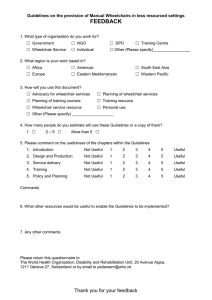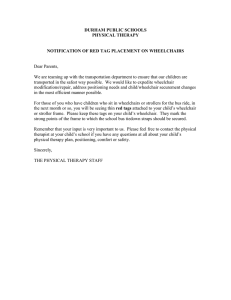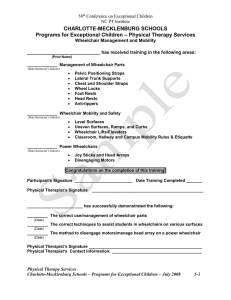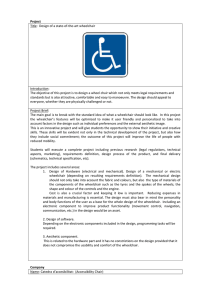Answer Key - APA Medical
advertisement
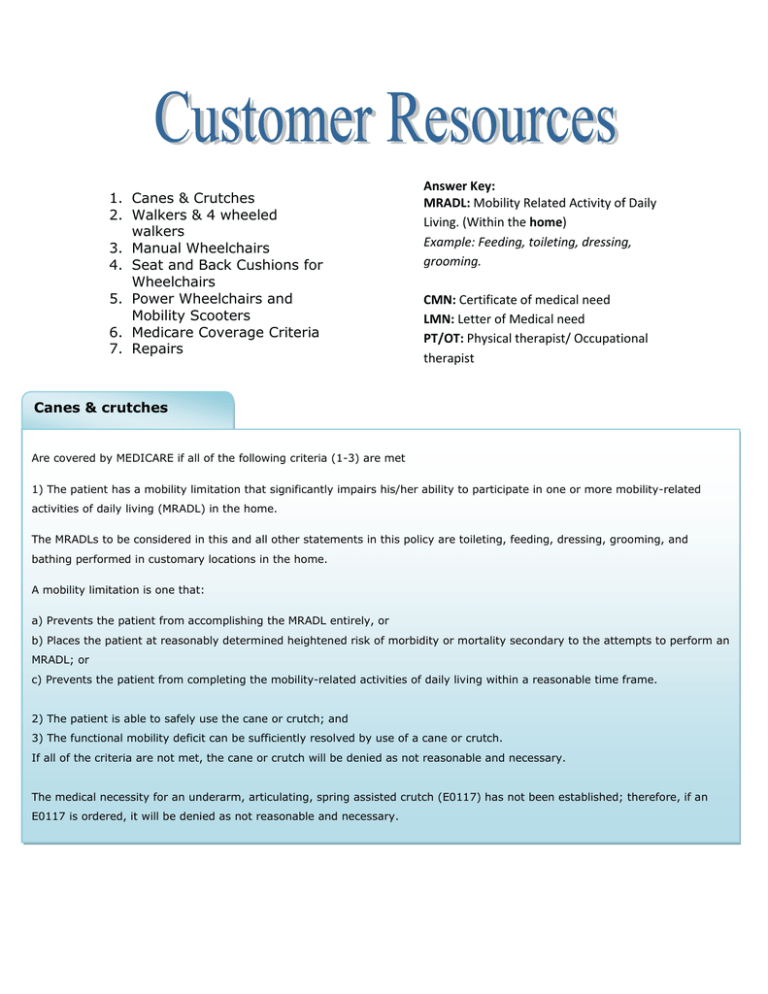
1. Canes & Crutches 2. Walkers & 4 wheeled walkers 3. Manual Wheelchairs 4. Seat and Back Cushions for Wheelchairs 5. Power Wheelchairs and Mobility Scooters 6. Medicare Coverage Criteria 7. Repairs Answer Key: MRADL: Mobility Related Activity of Daily Living. (Within the home) Example: Feeding, toileting, dressing, grooming. CMN: Certificate of medical need LMN: Letter of Medical need PT/OT: Physical therapist/ Occupational therapist Canes & crutches Are covered by MEDICARE if all of the following criteria (1-3) are met 1) The patient has a mobility limitation that significantly impairs his/her ability to participate in one or more mobility-related activities of daily living (MRADL) in the home. The MRADLs to be considered in this and all other statements in this policy are toileting, feeding, dressing, grooming, and bathing performed in customary locations in the home. A mobility limitation is one that: a) Prevents the patient from accomplishing the MRADL entirely, or b) Places the patient at reasonably determined heightened risk of morbidity or mortality secondary to the attempts to perform an MRADL; or c) Prevents the patient from completing the mobility-related activities of daily living within a reasonable time frame. 2) The patient is able to safely use the cane or crutch; and 3) The functional mobility deficit can be sufficiently resolved by use of a cane or crutch. If all of the criteria are not met, the cane or crutch will be denied as not reasonable and necessary. The medical necessity for an underarm, articulating, spring assisted crutch (E0117) has not been established; therefore, if an E0117 is ordered, it will be denied as not reasonable and necessary. Walkers & Rollators Medicare pays for walkers with our without wheels if a patient has a mobility limitation that significantly impairs his/her ability to participate in one or more mobility-related activities of daily living (MRADL) in the home; o Prevents the patient from accomplishing the MRADL entirely, or o Places the patient at reasonably determined heightened risk of morbidity or mortality secondary to the attempts o to perform the MRADL, or Prevents the patient from completing the MRADL within a reasonable time frame the patient is able to safely use the walker and the functional mobility deficit can be sufficiently resolved with use of a walker. A heavy duty walker is covered for patients who meet coverage criteria for a standard walker and who weigh more than 300 pounds. A heavy duty, multiple braking system, variable wheel resistance walker is covered for patients who meet coverage criteria for a standard walker and who are unable to use a standard walker due to a severe neurologic disorder or other condition causing the restricted use of one hand. Obesity, by itself, is not a sufficient reason for an E0147 walker. If an 4 wheeled walker is provided and if the additional coverage criteria are not met, it will be denied as not reasonable and necessary. Medicare pays for 4 wheeled walkers up to $130 (keep in mind that Medicare pays 80% of allowable, 20% must be paid by patient or secondary payer). The difference between the cost of the 4 wheeled walkers and Medicare paid amount is patient’s responsibility. Please note that if you have received a regular walker from Medicare and now need a 4 wheeled walkers, Medicare will not pay for it because it will be considered same or similar equipment and change in condition will not justify the new equipment. The 4 wheeled walkers will be reimbursed if the patient has a neurological disorder or other condition restricting the use of one hand. Knee walkers or walker accessories are not covered by Medicare. Manual Wheelchairs Medicare pays for standard/lightweight manual wheelchairs and transport wheelchairs on a capped rental basis. This means that the equipment is rental 13 months and is the property of APA Medical Equipment and must be returned to us if the patient is no longer in need of the equipment, has moved into a Skilled Nursing Facility or has passed away. After Medicare pays for the 13 months rental, the equipment will become the beneficiaries. If repairs or maintenance is required on patient owned equipment, Medicare may pay for the repairs. Because the equipment is a rental for the initial 13 months, APA Medical Equipment can only rent within our service area and cannot bill Medicare for manual wheelchairs or transport wheelchairs purchased online or from other suppliers. A manual wheelchair is covered if: Criteria A, B, C, D, and E are met; and Criterion F or G is met. Additional coverage criteria for specific devices are listed below. A) The patient has a mobility limitation that significantly impairs his/her ability to participate in one or more mobility-related activities of daily living such as toileting, feeding, dressing, grooming, and bathing in customary locations in the home. A mobility limitation is one that would: 1. 2. Prevent the patient from accomplishing an MRADL entirely, or places the patient at reasonably determined heightened risk of morbidity or mortality secondary to the attempts to perform an MRADL; or Prevents the patient from completing an MRADL within a reasonable time frame B) The patient’s mobility limitation cannot be sufficiently resolved by the use of an appropriately fitted cane or walker. C) The patient’s home provides adequate access between rooms, maneuvering space, and surfaces for use of the manual wheelchair that is provided. D) Use of a manual wheelchair will significantly improve the patient’s ability to participate in MRADLs and the patient will use it on a regular basis in the home. E) The patient has not expressed an unwillingness to use the manual wheelchair that is provided in the home. F) The patient has sufficient upper extremity function and other physical and mental capabilities needed to safely self-propel the manual wheelchair that is provided in the home during a G) The patient has a caregiver who is available, willing, and able to provide assistance with the wheelchair. If the manual wheelchair will be used inside the home and the coverage criteria are not met, it will be denied as not medically necessary. If the manual wheelchair will only be used outside the home, it will be denied as not medically necessary. A standard hemi-wheelchair (K0002) is covered when the patient requires a lower seat height (17" to 18") because of short stature or to enable the patient to place his/her feet on the ground for propulsion. A lightweight wheelchair (K0003) is covered when a patient: 1. 2. The patient self-propels the wheelchair while engaging in frequent activities in the home that cannot be performed in a standard wheelchair. The patient requires a seat width, depth, or height that cannot be accommodated in a standard, and spends at least two hours per day in the wheelchair. A high strength lightweight wheelchair is rarely medically necessary if the expected duration of need is less than three months (e.g., post-operative recovery). A heavy duty wheelchair (K0006) is covered if the patient weighs more than 250 pounds or the patient has severe spasticity. An extra heavy duty wheelchair (K0007) is covered if the patient weighs more than 300 pounds. Coverage of an ultra-lightweight wheelchair (K0005) and manual tilt in space wheelchair (E1161) are determined on an individual consideration basis. Ultra-lightweight wheelchairs and tilt in space wheelchairs are paid for as a purchase because they must be custom ordered based on patient’s specifications and needs - pending Advance Determination of Medical Coverage. Patient’s medical records can be submitted to Medicare to determine coverage. This can take up to 30 days after the necessary documentation has been provided by the physician and other clinicians. Please contact APA Medical Equipment for more detailed coverage determination. Payment is made for only one wheelchair at a time. Backup chairs are denied as not reasonable and necessary. One month's rental of a wheelchair is covered if a patient-owned wheelchair is being repaired. Sport wheelchairs and bathroom wheelchairs are not covered by Medicare. Seat and Back Cushions for Wheelchairs A general use seat cushion and a general use wheelchair back cushion are covered for a patient who has a manual wheelchair or a power wheelchair with a sling/solid seat/back which meets Medicare coverage criteria. If the patient does not have a covered wheelchair, then the cushion will be denied as not medically necessary. If the patient has a scooter or a power wheelchair with a captain's chair seat, it will be denied as not medically necessary. A skin protection seat cushion is covered for a patient who meets both of the following criteria: 1) The patient has a manual wheelchair or a power wheelchair with a sling/solid seat/back and the patient meets Medicare coverage criteria for it; and 2) The patient has either of the following: a) Current pressure ulcer or past history of a pressure ulcer on the area of contact with the seating surface; or b) Absent or impaired sensation in the area of contact with the seating surface or inability to carry out a functional weight shift due to one of the following diagnoses: spinal cord injury resulting in quadriplegia or paraplegia (344.00-344.1), other spinal cord disease (336.0-336.3), multiple sclerosis (340), other demyelinating disease (341.0-341.9), cerebral palsy (343.0-343.9), anterior horn cell diseases including amyotrophic lateral sclerosis (335.0-335.21, 335.23-335.9), post polio paralysis (138), traumatic brain injury resulting in quadriplegia (344.09), spina bifida (741.00-741.93), childhood cerebral degeneration (330.0-330.9), Alzheimer’s disease (331.0), Parkinson’s disease (332.0). A positioning seat cushion and positioning back cushion is covered for a patient who meets both of the following criteria: 1) The patient has a manual wheelchair or a power wheelchair with a sling/solid seat/back and the patient meets Medicare coverage criteria for it; and 2) The patient has any significant postural asymmetries that are due to one of the diagnoses listed in criterion 2b above or to one of the following diagnoses: monoplegia of the lower limb (344.30-344.32, 438.40-438.42) or hemiplegia (342.00342.92, 438.20-438.22) due to stroke, traumatic brain injury, or other etiology, muscular dystrophy (359.0, 359.1), torsion dystonias (333.4, 333.6, 333.71), spinocerebellar disease (334.0-334.9). A headrest is also covered when the patient has a covered manual tilt-in-space wheelchair, manual semi or fully reclining back on a manual wheelchair, a manual fully reclining back on a power wheelchair, or power tilt and/or recline power seating system. If the patient has a mobility scooter or a power wheelchair with a captain's chair seat, a headrest or other positioning accessory will be denied as not medically necessary. A combination skin protection and positioning seat cushion is covered for a patient who meets the criteria for both a skin protection seat cushion and a positioning seat cushion. A seat or back cushion that is provided for use with a transport wheelchair (E1037, E1038) will be denied as not medically necessary. The effectiveness of a powered seat cushion (E2610) has not been established. Claims for a powered seat cushion will be denied as not medically necessary Power Wheelchairs & Mobility Scooters APA Medical Equipment will guide you through the entire process of obtaining a power wheelchair or scooter through Medicare. We work directly with Medicare and your physician to obtain the necessary documentation to get approved for the prescribed equipment. The Phone Call The process begins with your call or e-mail to request information about Power Wheelchairs or Scooters. Our Mobility Specialists will answer every question you have and gather the necessary information (address, phone number, medical problems, etc.) to create your confidential file. Visit the Doctor The next step is meeting with your doctor for your power mobility evaluation. Medicare requires a doctor’s prescription for Power Wheelchairs coverage. (If you plan to use Medicare for payment, it is important to schedule your doctor’s appointment right away.) This doctor's visit must be specifically for your face-to-face mobility evaluation, not a general appointment. During the mobility evaluation, your doctor will ask you a series of questions to determine if a power mobility product is medically necessary. If your doctor prescribes a power mobility device, we will work with your doctor to complete the required paperwork. (See Medicare Coverage Criteria) The Paperwork We work with Medicare to complete the paperwork process. We will help you get the right equipment for you at little or no cost to you. PT/OT Evaluations Sometimes this may be required if your Doctor elects to refer you to another medical professional, such as a physical therapist or occupational therapist, to perform the physical part of the evaluation. However, you do have to personally see the Doctor before or after the PT/OT evaluation. The Doctor must still provide a prescription that would need to be forwarded to the supplier (APA Medical) within 45 days of your face to face examination. Once you have completed the PT/OT appointment, your Doctor must review the therapists report, indicate his/hers agreement in writing on the report, and sign and date the report and return or forward this document to the medical suppler. APA Mobility Evaluation We will fit your power wheelchair to your body measurements for complete comfort. We guarantee your new power wheelchair will fit your body proportions and will work in your home. Delivery We deliver the equipment to your home with no delivery charges to you. At delivery, we instruct you on how to operate your new power mobility device within your home. Based on Medicare guidelines, we are responsible for delivery, setup, and training of equipment, therefore we cannot provide service for Medicare beneficiaries that live outside of our area. Repair and Maintenance If your power wheelchair requires repairs please contact us and we will send a technician out to you. Note: There is a standard service fee of 50.00 for Repairs on privately owned equipment. Example of privately owned equipment: Is equipment that was purchased not through insurance, but either donated or paid for out of pocket. Medicare Coverage Criteria For a power wheelchair (PWC) or mobility scooter (POV – power operated vehicle) to be covered, we must receive from the treating physician a written order (prescription) containing all of the following elements: 1. 2. 3. 4. 5. 6. 7. Beneficiary’s name Description of the item that is ordered. This may be general – e.g., “power wheelchair”, “power operated vehicle”, or “power mobility device”– or may be more specific. Date of the face-to-face examination Pertinent diagnoses/conditions that relate to the need for the power wheelchair Length of need Physician’s signature Date of physician signature This order must be received by APA Medical Equipment within 45 days after completion of the physician’s face-to-face examination and prior to delivery of the device. (Exception: If the examination is performed during a hospital or nursing home stay, we must receive the order within 45 days after discharge.) Face-to-face examination: For a power wheelchair or mobility scooter to be covered, the treating physician must conduct a face-to-face examination of the patient before writing the order and submit to APA Medical Equipment within 45 days of the face-to-face examination and prior to delivery of the device. If this requirement is not met, the claim will be denied as non-covered. The report of the face-to-face examination shall provide information relating to the following questions: What is this patient’s mobility limitation and how does it interfere with the performance of activities of daily living? Why can’t a cane or walker meet this patient’s mobility needs in the home? Why can’t a manual wheelchair meet this patient’s mobility needs in the home? If a powered wheelchair is provided, why can’t a mobility scooter meet this patient’s mobility needs in the home? Does this patient have the physical and mental abilities to operate a power wheelchair or mobility scooter safely in the home? Is the patient willing and motivated to use the power wheelchair or mobility scooter The report shall provide pertinent information about the following elements, but may include other details. Each element would not have to be addressed in every evaluation. Symptoms Related diagnoses History How long the condition has been present Clinical progression Interventions (including medications) that have been tried and the results Past use of walker, manual wheelchair, mobility scooter or power wheelchair and the results Physical exam Weight Impairment of strength, range of motion, sensation, or coordination of arms and legs Presence of abnormal tone or deformity of arms, legs, or trunk Neck, trunk, and pelvic posture and flexibility Sitting and standing balance Functional assessment – any problems with performing the following activities including the need to use a cane, walker, or the assistance of another person Transferring between a bed, chair, and power wheelchair Walking around their home – to bathroom, kitchen, living room, etc. – provide information on distance the patient is able to walk without stopping, speed, and balance The elements that are addressed will depend on the diagnoses that are responsible for the mobility deficit. For example, for patients with COPD, heart failure, or arthritis, the major emphasis will be on symptoms and history of the progression of their condition rather than on the physical examination. Functional assessment is important for all patients. Physicians shall also provide reports of pertinent laboratory tests, x-rays, and/or other diagnostic tests (e.g., pulmonary function tests, cardiac stress test, electromyogram, etc.) performed in the course of management of the patient. Physicians shall document the evaluation in a detailed narrative note in their charts in the format that they use for other entries. The note must clearly indicate that a major reason for the visit was a mobility evaluation. Repairs & Replacement Repair To repair means to fix or mend and to put the equipment back in good condition after damage or wear. Repairs to equipment which a beneficiary owns are covered when necessary to make the equipment serviceable. If the expense for repairs exceeds the estimated expense of purchasing or renting another item of equipment for the remaining period of medical need, no payment can be made for the amount of the excess. Repairs of rented equipment are not covered. This includes items in the frequent and substantial servicing, oxygen equipment, capped rental, and inexpensive or routinely purchased payment categories which are being rented. Replacement Replacement refers to the provision of an identical or nearly identical item. Equipment which the beneficiary owns or is a capped rental item may be replaced when it has been in continuous use for the reasonable lifetime designated for the equipment, or in cases of loss, theft, or irreparable damage. Irreparable damage refers to a specific accident or to a natural disaster (e.g., fire, flood, etc.). Irreparable wear refers to deterioration sustained from day-to-day usage over time and a specific event cannot be identified. Replacement of equipment due to irreparable wear takes into consideration the reasonable useful lifetime of the equipment. If the equipment has been in continuous use by the patient on either a rental or purchase basis for the equipment's useful lifetime, the beneficiary may elect to obtain a new piece of equipment. However, if the equipment has not been in continuous use by the patient on either a rental or purchase basis for the equipment’s useful lifetime, the supplier who transferred the title of ownership to the patient is responsible for furnishing replacement equipment at no cost to the beneficiary or to the Medicare Program. The reasonable useful lifetime of DME is determined through program instructions. In the absence of program instructions, carriers may determine the reasonable useful lifetime of equipment, but in no case can it be less than five years. Computation of the useful lifetime is based on when the equipment is delivered to the beneficiary, not the age of the equipment. Replacement due to wear is not covered during the reasonable useful lifetime of the equipment. During the reasonable useful lifetime, Medicare does cover repair up to the cost of replacement (but not actual replacement) for medically necessary equipment owned by the beneficiary. Replacement may be reimbursed when a new physician order and/or new initial CMN (CERTIFICATE OF MEDICAL NEED), when required, is needed to reaffirm the medical necessity of the item.
